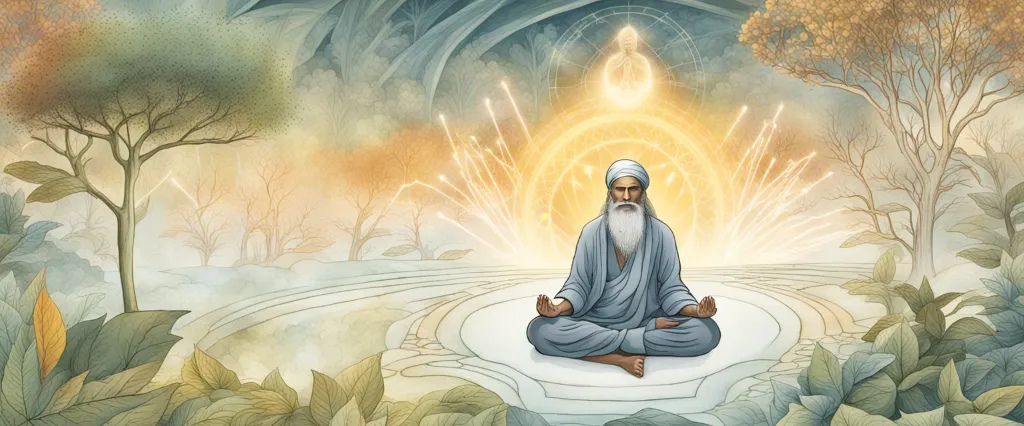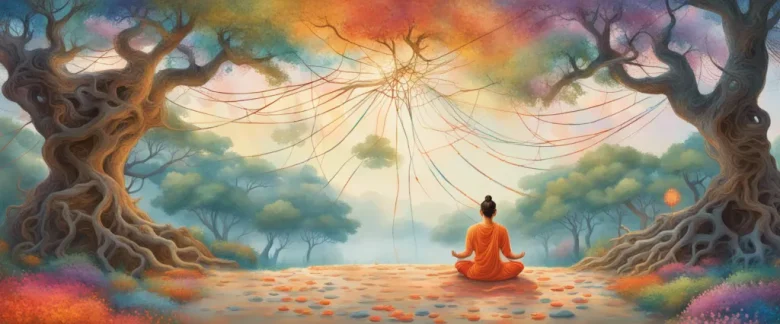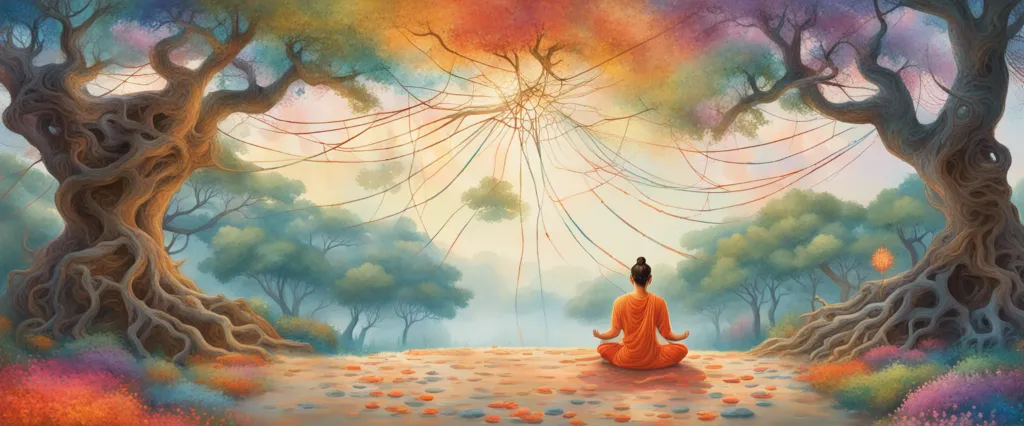In his enlightening book, “Karma,” renowned spiritual leader Sadhguru provides a profound exploration of one of life’s most profound concepts. Through his deep understanding and insightful observations, Sadhguru invites readers to delve into the intricate workings of karma and its implications on our everyday lives. An internationally acclaimed yogi, mystic, and visionary, Sadhguru’s teachings have touched millions, empowering individuals to seek inner transformation and discover true joy. Through this book, he offers readers a transformative journey towards understanding karma and its role in shaping our destinies.
Chapter 1: The Essence of Karma
Chapter 1: The Essence of Karma of the book “Karma: A Yogic Perspective” by Sadhguru explores the concept of karma and its significance in our lives. The chapter begins by explaining that the word karma means “action” and is derived from the Sanskrit root “kri,” meaning to do. Sadhguru highlights that every action we perform has consequences, and these consequences become our karma.
The chapter delves into the idea that karma is not just about moral consequences, but also about the impact our actions have on our personal growth and well-being. It emphasizes that our actions shape our destiny and that there is no escape from the consequences of our actions.
Sadhguru discusses the different types of karma, such as sanchita karma (accumulated karma from past lifetimes), prarabdha karma (karma we are currently experiencing), and agami karma (karma we generate in the present). He explains that these different karmas influence our emotions, relationships, and overall life experiences.
Furthermore, Sadhguru explores the concept of intention behind our actions and highlights that when our intentions are aligned with the larger well-being, our karma can become transformative. He encourages individuals to take responsibility for their actions and make conscious choices to create positive outcomes.
The chapter also stresses the importance of self-awareness and the need to understand ourselves before trying to understand the consequences of our actions. Sadhguru asserts that by observing our thoughts, emotions, and actions, we can become conscious creators of our own destiny.
In summary, Chapter 1 of “Karma: A Yogic Perspective” provides an introduction to the concept of karma, emphasizing the importance of actions and their consequences in shaping our lives. It explores different types of karma, the significance of intention behind actions, and the need for self-awareness in order to make conscious choices.
Chapter 2: The Power of Action
Chapter 2: The Power of Action delves into the concept of karma as explained by Sadhguru in his book Karma. He begins by stating that karma is not an external law or punishment system but rather a fundamental process of existence. Karma refers to the actions and consequences we experience in our lives, shaped primarily by the choices we make.
Sadhguru emphasizes the importance of understanding the two dimensions of action: intense activity and deep stillness. He explains that intense activity brings forth dynamic energy, enabling us to accomplish things in the external world. However, without experiencing deep stillness and understanding the source of action, we risk getting entangled in the cycle of karma.
The chapter highlights the significance of conscious action. Sadhguru argues that the outcome of an action is not as important as the level of involvement and engagement we bring into it. He suggests that being fully present in every action and performing with utmost involvement allows us to experience the power of action, leading to a sense of fulfillment and growth.
Sadhguru further explores the concept of action without desire, emphasizing the importance of performing our duties without attachment to the results. He asserts that when an individual is free from the attachment to the outcome, their actions become more spontaneous and effective. By focusing on the process rather than obsessing over the outcomes, one becomes capable of engaging in action at a deeper level without being influenced by external factors.
In conclusion, Chapter 2 emphasizes the significance of understanding and consciously engaging in actions. By incorporating both intense activity and deep stillness, one can experience the power of action and transcend the cycle of karma, leading to a more fulfilling and purposeful life.
Chapter 3: The Cycle of Karma
Chapter 3: The Cycle of Karma of the book “Karma: A Yogi’s Guide to Crafting Your Destiny” by Sadhguru explores the intricate mechanism of karma and how it influences our lives. Sadhguru begins by defining karma as the accumulated residue of our thoughts, emotions, and actions, which shapes our experiences and determines our destiny.
He explains that karma functions as a cause-and-effect cycle, where every action we perform generates a corresponding reaction or consequence. This process is not limited to this lifetime alone but extends beyond, carrying forward into future rebirths. Sadhguru emphasizes that karma is not about punishment or reward but rather an intricate mechanism that enables growth, evolution, and self-realization.
The chapter delves into the three types of karma: sanchita karma (accumulated karma from previous lives), prarabdha karma (karma that manifests as our current life’s experiences), and agami karma (karma we accumulate from present actions). Sadhguru highlights that understanding these distinctions brings clarity to our experiences, allowing us to consciously shape our future karma.
Sadhguru further explains that karma is not about escaping or avoiding actions but rather shifting the quality of our actions from unconscious to conscious. He emphasizes the need to cultivate awareness and intent in our actions to break free from the cycle of unconscious accumulation of karma. By bringing awareness to every action, we can untangle ourselves from past karmic patterns and create a more conscious and purposeful future.
In this chapter, Sadhguru provides practical insights and techniques to become more conscious in our actions and ultimately transcend the cycle of karma. He offers guidance on how to engage with life in a way that empowers us to shape our destiny consciously, ultimately leading to liberation from the cycle of birth and death.
Chapter 4: Freedom and Destiny

Chapter 4 of the book “Karma” by Sadhguru, titled “Freedom and Destiny,” delves into the concept of karma and its relationship with freedom and destiny. Sadhguru explores the idea that while many perceive karma as a limiting force, it can actually be a path to liberation.
Sadhguru begins by emphasizing that karma is not a form of punishment or reward imposed by external forces. Instead, he explains karma as the result of our own actions and their impact on our lives. He highlights the interconnectedness of all existence and how our actions create a ripple effect that has consequences.
The chapter discusses the notion that freedom and destiny are not mutually exclusive. While destiny establishes the framework within which our lives unfold, freedom lies in how we choose to respond to our circumstances. Sadhguru argues that true freedom is not about escaping or avoiding one’s destiny, but rather embracing it and consciously shaping it.
He outlines the importance of developing awareness and mastering one’s actions, as our actions determine the quality of our lives and our karmic cycle. Sadhguru suggests that by becoming more conscious and dissolving our identification with the ego, we can transcend the limitations imposed by karma and create a path towards liberation.
Through anecdotes and insightful explanations, Sadhguru reminds readers that life is not about becoming a victim of one’s circumstances or external forces. Instead, he encourages readers to cultivate an attitude of responsibility and conscious action. By embracing our freedom within the framework of our destiny, we can shape our lives and move towards a more fulfilling existence.
In conclusion, Chapter 4 of “Karma” explores the relationship between freedom and destiny. Sadhguru provides a fresh perspective on karma, emphasizing that it is not a restrictive force, but rather a means to realize our true potential. By understanding our interconnectedness, taking responsibility for our actions, and consciously shaping our lives, we can move towards liberation and profound fulfillment.
Chapter 5: The Role of Consciousness
Chapter 5 of the book “Karma” by Sadhguru explores the role of consciousness in understanding and transforming karma. The chapter begins by asserting that consciousness is at the very core of our existence, shaping our thoughts, emotions, and actions. It highlights the interconnectedness of everything in the universe and emphasizes the role of human consciousness as a powerful tool for self-realization and karma management.
Sadhguru explains that our conscious awareness expands as we become more conscious of our own consciousness. By observing our thoughts, emotions, and desires, we can gain insight into the underlying patterns and influences that drive our actions. This self-awareness allows us to consciously choose how we respond to situations, rather than being reactionary and driven by unconscious conditioning.
The chapter highlights the importance of developing a meditative practice to enhance our conscious awareness. Through meditation, we can detach ourselves from our thoughts and emotions, enabling us to observe them objectively and gain a deeper understanding of ourselves. This heightened awareness empowers us to break free from the karmic cycle by consciously acting in alignment with our intentions and values.
Sadhguru also raises the idea of transcending individual karma and connecting with universal consciousness. By expanding our consciousness beyond the limitations of the individual self, we can tap into a larger cosmic intelligence and access a deeper sense of purpose and fulfillment. This shift in consciousness allows us to navigate life with greater clarity, compassion, and wisdom.
In summary, Chapter 5 of “Karma” delves into the significance of consciousness in understanding and transforming karma. It reveals that through self-awareness, meditation, and connecting with universal consciousness, we can break free from the limitations of our past actions and consciously shape our future, leading to a more conscious and fulfilling life.
Chapter 6: Freedom and Transcendence
Chapter 6: Freedom and Transcendence of the book “Karma” by Sadhguru explores the concept of freedom and its connection to transcendence in our lives. The chapter delves into the potential of human beings to rise above their limitations and find true liberation.
Sadhguru begins by explaining that true freedom is not about external circumstances but a state of being that is independent of any external influence. He emphasizes that freedom is not a goal to be achieved but a fundamental aspect of our inner nature that can be realized.
The chapter highlights the concept of karma, which is often misunderstood as a fatalistic belief in predetermined actions and outcomes. Sadhguru unravels the deeper meaning of karma and asserts that it is our individual actions and choices that shape our lives. He encourages readers to take responsibility for their actions rather than blaming external factors.
Sadhguru emphasizes the significance of transcending the limitations of body and mind to experience true freedom. He promotes various spiritual practices and methods that can help individuals break free from the constraints of their past actions and patterns. By cultivating awareness and detachment, one can rise above the karmic cycle and experience liberation.
Furthermore, the chapter explores the connection between freedom, transcendence, and self-realization. Sadhguru asserts that self-realization is the ultimate goal of human life, as it leads to absolute freedom and transcendence from all limitations. He encourages readers to explore their inner selves through introspection and meditation to realize their inherent freedom and transcendence.
In summary, Chapter 6 of “Karma” highlights the essence of freedom and transcendence in human existence. It encourages individuals to take responsibility for their actions, transcend their limitations, and seek self-realization for attaining true freedom.
Chapter 7: Interpreting Karma
Chapter 7 of the book “Karma” by Sadhguru focuses on understanding and interpreting the concept of karma. Sadhguru begins by emphasizing that karma is not just a mere consequence of our actions, but a much more profound process that determines the very nature of our existence and the experiences we go through.
According to Sadhguru, karma is essentially the accumulated memory and impressions of our past actions and experiences, both positive and negative. He explains that every action we perform leaves an imprint on our being, shaping our future experiences. Understanding this, he asserts that being conscious of our actions becomes crucial in preventing negative karma from accumulating.
Sadhguru goes on to discuss the three aspects of karma – Sanchita karma, Prarabdha karma, and Agami karma. Sanchita karma refers to the collective sum of all our past actions, while Prarabdha karma represents the portion of karma that is ripe for experiencing in our current lifetime. Agami karma, on the other hand, comprises the karma we accumulate with every action in the present moment. Sadhguru explains how these aspects are interconnected and influence our present and future experiences.
Additionally, Sadhguru explains that our interpretation of karma should not be limited to notions of reward and punishment. Instead, he suggests that karma is an opportunity for growth and an invitation to evolve beyond our limitations. By using the right tools and techniques, we can transform negative karma into a source of profound transformation and wisdom.
In conclusion, Chapter 7 of “Karma” delves into the deeper aspects of karma, emphasizing the significance of conscious action and highlighting the interconnectedness of our past, present, and future experiences. It encourages readers to interpret karma as a means to evolve rather than an arbitrary system of reward and punishment. By understanding the complexities of karma, one can take charge of their actions to shape a more desirable, fulfilling future.

Chapter 8: Creating Your Own Destiny
Chapter 8 of the book “Karma” by Sadhguru, titled “Creating Your Own Destiny,” delves into the concept of how individuals have the power to shape their own lives through conscious action.
Sadhguru begins by explaining that karma, often misunderstood as fate or predestined actions, is actually a result of our own choices and the consequences they bring. Our lives are not predetermined, but rather a culmination of our decisions and responses to various situations. By recognizing this, we can seize control of our destinies and create a life that aligns with our desires and aspirations.
The chapter emphasizes the importance of taking responsibility for our actions and interactions with the world. Sadhguru asserts that every thought, word, and action we engage in has an impact, shaping not only our own lives but also those of others. By being mindful of our intentions and the potential consequences, we can consciously shape a positive path for ourselves and sow seeds of future well-being.
Sadhguru introduces the concept of “Inner Engineering,” a process of self-transformation that empowers individuals to take charge of their destiny. Through inner exploration and self-awareness, we can break free from the limitations of external circumstances and create a life that is in harmony with our true nature.
The chapter concludes by emphasizing the need to align our actions with a higher vision, rather than being driven by external influences or societal expectations. By doing so, Sadhguru argues, we can navigate life’s challenges with greater resilience and create a reality that is reflective of our deepest aspirations.
In summary, Chapter 8 of “Karma” explores the notion that destiny is not fixed but can be crafted through conscious choices and actions. It encourages readers to take ownership of their lives, practice self-awareness, and align their actions with a higher purpose to create a fulfilling and meaningful existence.
After Reading
In conclusion, “Karma” by Sadhguru provides a thought-provoking exploration of the concept of karma and its implications in our lives. The book delves into the understanding that our actions have consequences and that we are responsible for the outcomes we experience. Sadhguru emphasizes the importance of consciously choosing our thoughts, words, and deeds to create positive karmic cycles. By cultivating awareness and making conscious choices, we can break free from negative patterns and create a life filled with harmony and purpose. Through profound insights and practical guidance, Sadhguru invites readers to discover the transformative power of karma, enabling them to live a more fulfilling and meaningful existence.
1. The Power of Now” by Eckhart Tolle – This book delves into spiritual awakening, emphasizing the importance of living in the present moment and letting go of past regrets and future worries.
2. The Alchemist” by Paulo Coelho – A timeless classic, this book explores the journey of self-discovery and following one’s personal legend. Its profound insights into the universe and the power of destiny will leave readers reflecting on their own lives.
3. Man’s Search for Meaning” by Viktor E. Frankl – In this powerful memoir, Frankl, a Holocaust survivor, explores the search for a sense of purpose and meaning in life. It offers deep insights into the human condition, resilience, and the importance of finding one’s personal mission.
4. “Siddhartha” by Hermann Hesse – This novel follows the spiritual journey of Siddhartha, a young man on a quest for enlightenment. Through his experiences, the book delves into themes of self-discovery, wisdom, and the search for universal truths.
5. “The Celestine Prophecy” by James Redfield – This gripping spiritual adventure follows the protagonist as he uncovers nine insights that provide valuable lessons on finding meaning, connecting with others, and understanding the interconnectedness of all life. It’s a thought-provoking read that encourages readers to explore their own spiritual journey.




